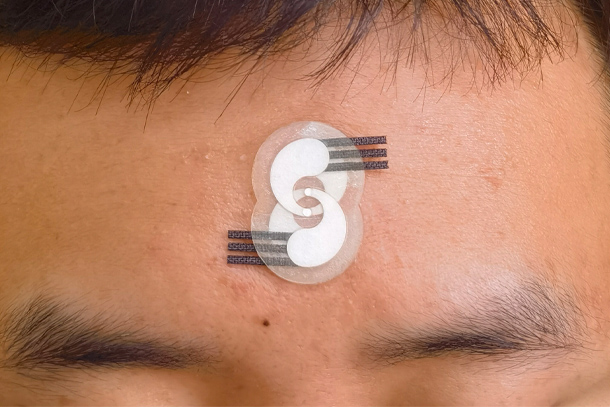
An electrochemical sensor, like this one developed by reserachers, can be placed on the forehead and provide real-time data on a patient’s neurological conditions so as to more accurately treat them with pain medications. Credit: Provided by Huanyu "Larry" Cheng
Q&A with Larry Cheng: Monitoring neurological conditions in real time
March 11, 2024
By Mariah R. Lucas
UNIVERSITY PARK, Pa. — A team of researchers led by Huanyu “Larry” Cheng, the James L. Henderson, Jr. Memorial Associate Professor of Engineering Science and Mechanics (ESM) at Penn State, created a highly-sensitive and cost-effective sensor to better monitor the concentration of dopamine and tyrosine — a neurotransmitter and an amino acid, respectively, that are present in the brain — in sweat or urine.
The concentration of dopamine and tyrosine in the body, which affect human emotion and behavior, can reflect the condition of patients with neurological conditions like Parkinson’s disease, schizophrenia, Alzheimer’s disease and hypochondria.
According to Cheng, the new sensor could potentially assist with the treatment of these diseases by providing real-time data on a patient’s conditions so as to more accurately treat them with pain medications like paracetamol. The researchers, including co-corresponding author Jia Zhu, a former Penn State doctoral student in ESM who is now an associate professor at the University of Electronic Science and Technology of China, published their work in the journal Small.
Penn State News caught up with Cheng on the implications of this work.
Q: Why are you personally interested in developing solutions for patients with neurological diseases?
Cheng: While the elderly are at a high risk of neurological disorders, our team also has interacted with many from younger generations who suffer from these conditions. Besides disease screening, diagnostic confirmation and treatment evaluation, monitoring biomarkers in biological fluids can help with the evaluation of various physiological and behavioral processes in the nervous system such as perception, movement, learning, memory and emotion. We are interested in developing non-invasive wearable sensors to monitor people’s conditions as they age.
Q: Can you describe the materials and how they are used to detect biomarkers?
Cheng: Titanium dioxide (TiO2), which has great biocompatibility and high reactivity, can be an excellent sensing material for detecting biomarkers like dopamine and tyrosine in sweat or urine. By leveraging the polymer-assisted deposition, a high-quality TiO2 film can be prepared efficiently at low cost. The TiO2 film can be patterned by laser scribing and transferred to flexible or stretchable substrates, such as carbon cloth, as working electrodes in the electrochemical sensor, then applied to a sensing platform like a skin patch or smart diaper.
Q: Can you describe the benefits of using a skin patch or smart diaper sensor instead of traditional methods of measuring biomarkers, like blood tests?
Cheng: Blood sampling cannot be performed on a continuous basis and only provides snapshots of measurements. Electrochemical detection of sweat can be used to monitor metabolites and drugs in place. Urine analysis provides a fast and convenient method to monitor the physiological status of patients with limited mobility for timely treatment when necessary.
Q: According to the paper, the electrochemical sensor has the potential application of being integrated into a smart diaper to detect trace amounts of dopamine. What are smart diapers, and how would this benefit patients with limited mobility?
Cheng: Integrating a flexible electrochemical sensor and a wireless module into a disposable diaper creates a “smart” diaper that allows for real-time and wireless analysis of dopamine concentrations in urine, as well as wetting dynamics.
Adults with limited mobility, such as the elderly or those recovering from surgical operations, could benefit from quick readings of dopamine levels for disease diagnostics, screenings or evaluations. Due to the pliant, thin material of the sensors, the smart diaper does not cause discomfort or result in a rash after a day's use.



